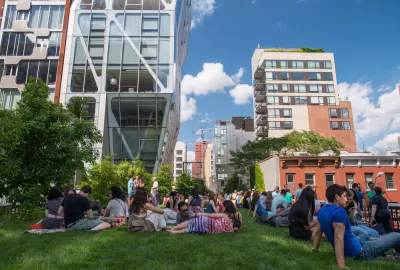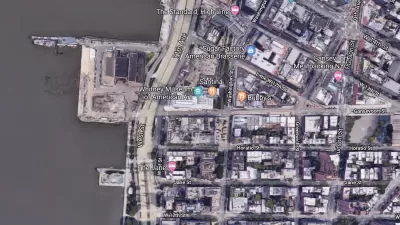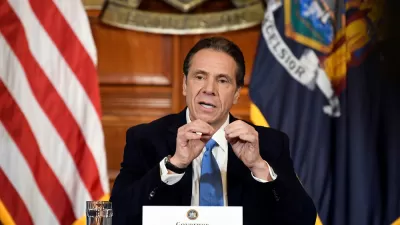As the High Line turns ten, a debate about the costs and benefits of urban revitalization continues.

Karrie Jacobs writes about the tenth anniversary of the High Line in New York City, admitting a rediscovered appreciation for the sometimes maligned, but always widely admired, piece of adaptive reused public space.
That renewed appreciation, writes Jacobs, was gained from the perspective offered from the High Line's new neighbor at Hudson Yards, the much less admired Vessel.
Aspects of the elevated walkway that felt overdesigned a decade ago—the benches that sometimes appear to grow directly out of the pavement, the seating areas that step downward toward views of the street, the careful plantings, the blocks of cement with carefully spaced cracks in between—now struck me as generous. Maybe it’s because so much of the world seems contrived today, but there’s a sincerity to it, an honest desire to respond to the needs of the public, to draw them in, to inspire their curiosity, to make them notice the underlying structure of the park, the artworks interspersed with the plantings, and also—maybe especially—to observe the surrounding city.
Jacobs's renewed appreciation of the High Line contrasts with the criticisms of Justin Davidson published earlier this year.
Today, the High Line serves as an elevated cattle chute for tourists, who shuffle from the Whitney to Hudson Yards, squeezed between high glass walls and luxury guard towers. The views are mostly gone, which is a good thing because stopping to admire one would cause a 16-pedestrian pileup. The rail-level traffic mirrors the congestion overhead, caused by construction so hellbent on milking New York’s waning real estate hyper-boom that any patch of land bigger than a tick’s front yard is considered suitable for luxury condos.
Jacobs endeavors to counter other criticisms, too—like the idea that "this park, every new urban park, is an evil act of alchemy." That argument misses an important point, according to Jacobs, about what the neighborhoods around the High Line have become, and what they might have become without the High Line being built.
Would New York be better or worse off without the High Line? The answer depends on whether we (those of us not in the market for a $48 million penthouse, anyway) get any value out of having buildings by Hadid, BIG, Heatherwick, and other luminaries in our city. If the alternative scenario would be the High Line as an undeveloped industrial ruin, surrounded by a West Chelsea of taxi garages and low-rent artists, I’d say screw the starchitects. But the more likely scenario, assuming the High Line hadn’t been restored, would be something that resembles Riverside South, a mostly residential complex some 30 blocks uptown along another disused railroad property. A lineup of 19 buildings with little to recommend them architecturally, they nevertheless remain largely unaffordable to most of us. The High Line, for better or worse, created a context for a kind of residential architecture that hadn’t previously existed in New York City. We couldn’t have gotten the park without the development, but we could easily have gotten the development without the park.
In the end, Jacobs decides that the High Line is an open-air museum of the present moment. The city is radically different than it was ten years ago, Jacobs writes, and the High Line is where to go to immerse in the city of New York as it exists today.
FULL STORY: The High Line at 10

Maui's Vacation Rental Debate Turns Ugly
Verbal attacks, misinformation campaigns and fistfights plague a high-stakes debate to convert thousands of vacation rentals into long-term housing.

Planetizen Federal Action Tracker
A weekly monitor of how Trump’s orders and actions are impacting planners and planning in America.

San Francisco Suspends Traffic Calming Amidst Record Deaths
Citing “a challenging fiscal landscape,” the city will cease the program on the heels of 42 traffic deaths, including 24 pedestrians.

Adaptive Reuse Will Create Housing in a Suburban Texas Strip Mall
A developer is reimagining a strip mall property as a mixed-use complex with housing and retail.

Study: Anti-Homelessness Laws Don’t Work
Research shows that punitive measures that criminalized unhoused people don’t help reduce homelessness.

In U.S., Urban Gondolas Face Uphill Battle
Cities in Latin America and Europe have embraced aerial transitways — AKA gondolas — as sustainable, convenient urban transport, especially in tricky geographies. American cities have yet to catch up.
Urban Design for Planners 1: Software Tools
This six-course series explores essential urban design concepts using open source software and equips planners with the tools they need to participate fully in the urban design process.
Planning for Universal Design
Learn the tools for implementing Universal Design in planning regulations.
Heyer Gruel & Associates PA
JM Goldson LLC
Custer County Colorado
City of Camden Redevelopment Agency
City of Astoria
Transportation Research & Education Center (TREC) at Portland State University
Jefferson Parish Government
Camden Redevelopment Agency
City of Claremont




























